fuel consumption AUDI S3 SEDAN 2015 Owners Manual
[x] Cancel search | Manufacturer: AUDI, Model Year: 2015, Model line: S3 SEDAN, Model: AUDI S3 SEDAN 2015Pages: 282, PDF Size: 71.14 MB
Page 30 of 282
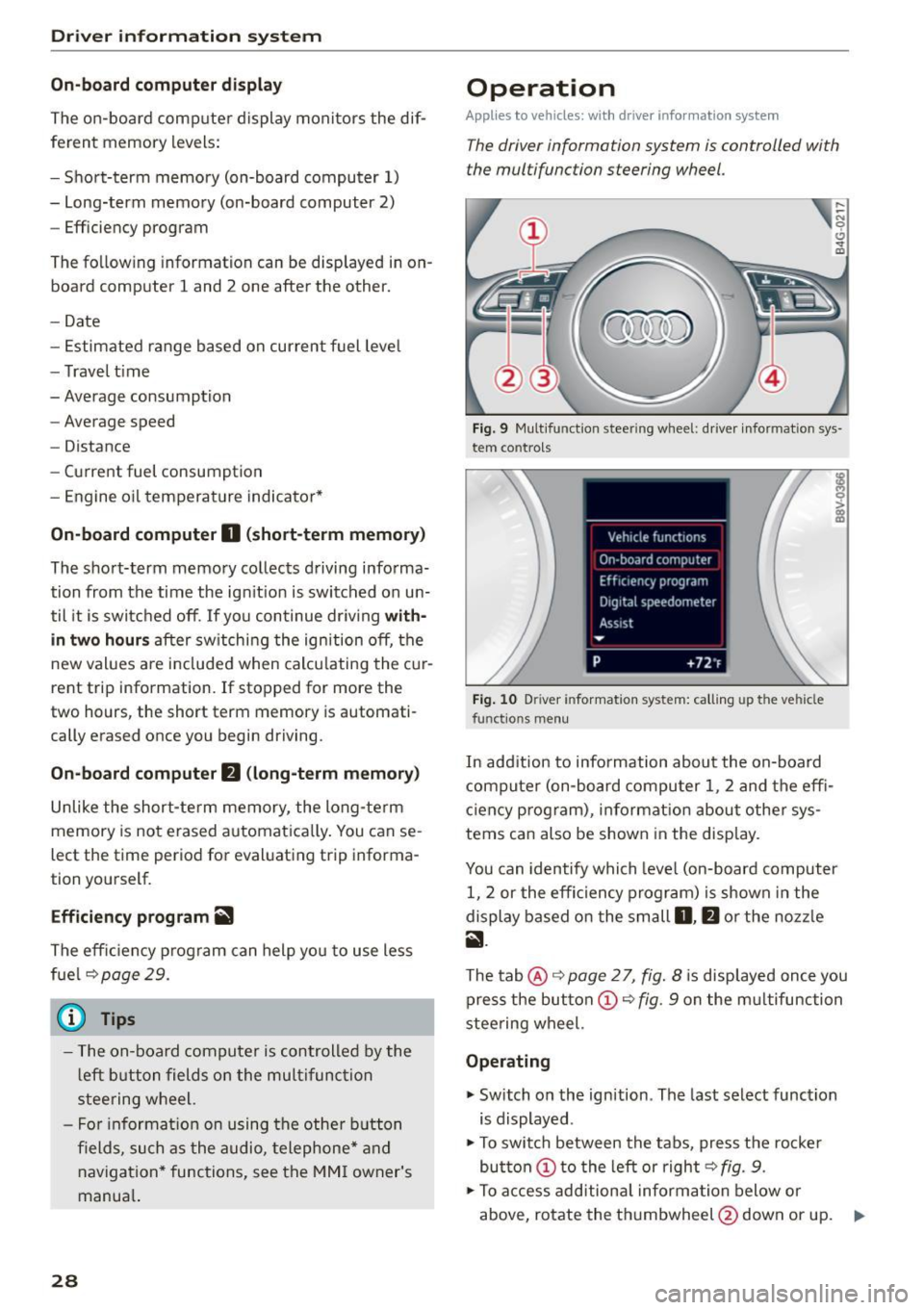
Drive r in formation syste m
On-board comput er display
The on-boa rd comp uter display monitors the dif
ferent memory levels:
- Short-term memory (on-board computer 1)
- Long-term memory (on-board computer 2)
- Efficiency program
The follow ing information can be displayed in on
board computer 1 and 2 one after the other.
-Date
- Estimated range based on current fuel leve l
- Travel time
- Average consumption
- Average speed
- Distance
- Current fuel consumption
- Engine o il temperature indicator*
On -board computer
D (sho rt -term memory )
The short-term memory collects driving informa
tion from the time the ign it ion is switched on un
til it is switched off . If you continue driving with
in tw o ho ur s after sw itchi ng the ignition off, the
new values are included when calcu lating the c ur
rent trip information. If stopped for more the
two hours , the short term memory is automati
cally erased once you begin driving.
On-board com put er
fJ (long-t erm m emor y)
Unlike the short-te rm memory, the long-term
memory is not erased automat ica lly. You can se
lect the time period for evaluating trip informa
tion yourself.
E fficie ncy program
ii
The effic iency program can help you to use less
fuel ~page29.
(j) Tips
- The on-board computer is controlled by the
l eft button fields on the multifunction
steering wheel.
- For information on using the other b utton
fields, such as the audio, telephone* and navigation * functions, see the MM I owner's
manua l.
28
Operation
Applies to vehicles: with driver information system
The driver information system is controlled with
the multifunction steering wheel.
Fig. 9 Mult ifunction steering wheel: driver informat ion sys
tem contro ls
Fig . 10 Dr iver info rmation system: ca lling up the vehicle
functions menu
In addition to information about the on-board
computer (on-board compu ter 1 , 2 and the effi
c iency prog ram), information about othe r sys
tems can also be shown in the display .
You can identify which level (on-board computer
1, 2 or the effi ciency program) is shown in the
display based on the small
D , fJ or the nozz le
ii .
The tab@~ page 2 7, fig. 8 is displayed once you
press the button
(D ~ fig . 9 on the m ultifunction
stee ring wheel.
Operating
"' Switch on the ignition . The last select function
is displayed .
"' To switch between the tabs, press the rocke r
button
(D t o the left or right ~ fig. 9.
"'To access add itiona l informa tion below or
above, rotate the thumbwheel @down or up.
9"'
Page 32 of 282
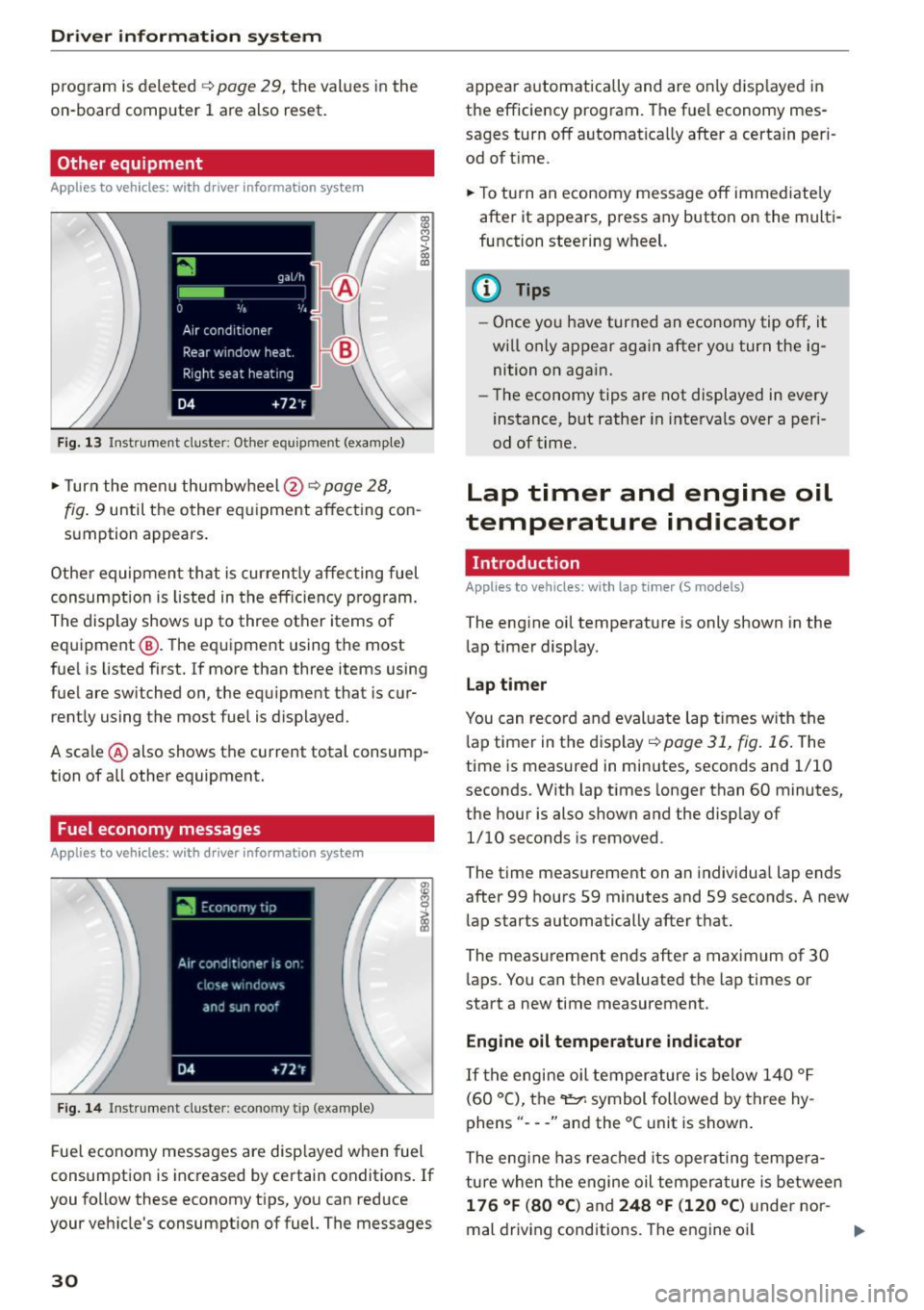
Driver information system
program is deleted ¢page 29, the values in the
on-board computer 1 are also reset.
Other equipment
Applies to vehicles: with driver information system
Fig. 13 Instrument cluster: Other equ ipment (examp le)
"'T urn the menu thumbwheel @ ¢ page 28,
l8 M 0
>
"' a,
fig. 9 until the other equipment affecting con
sumption appears.
Other equipment that is currently affecting fuel
consumption is listed in the efficiency prog ram.
The display shows up to three other items of
equipment @. The equipment using the most
fue l is listed first. If more than three items using
fuel are switched on, the equ ipment that is cur
rently using the most fuel is displayed.
A scale @ also shows the current total consump
tion of all other equipment.
Fuel economy messages
Applies to vehicles: with driver information system
Fig. 14 Instrument cluster: economy tip (example)
Fuel economy messages are disp layed when fuel
consumption is increased by certain conditions . If
you follow these economy tips, you can reduce
your veh icle's consumption of fuel. The messages
30
appear automatically and are only disp layed in
the efficiency program. The fuel economy mes
sages turn off automatically after a certain per i
od of t ime.
"'T o turn an economy message off immediate ly
after it appears, press any button on the multi
function steering wheel.
(D Tips
- Once you have turned an economy tip off, it
wi ll only appear again after you turn the ig
nition on again.
- The economy tips are not displayed in every
instance, but rather in intervals over a peri
od of time.
Lap timer and engine oil
temperature indicator
Introduction
Applies to veh icles: with lap tim er (S models)
The engine oil temperature is only shown in the
lap timer display.
Lap timer
You can record and evaluate lap times with the
l ap timer in the display¢
poge 31, fig. 16. The
time is measured in minutes, seconds and 1/10
seconds. With lap times longer than 60 minutes,
the hour is also shown and the display of
1/10 seconds is removed.
The time measurement on an individua l lap ends
after 99 hours 59 minutes and 59 seconds. A new
lap starts automatically after that.
The meas urement ends after a maximum of 30
laps. You can then eva luated the lap times or
start a new time measurement.
Engine oil temperature indicator
If the engine oil temperature is below 140 °F
(60 °C), the~ symbol followed by three hy
phens" ---" and the °C unit is shown .
The engine has reached its operating tempera
ture when the engine oil tempera ture is between
176 °F (80 °() and 248 °F (120 °C) under nor-
mal driving conditions. The engine oil
IJI>
Page 64 of 282
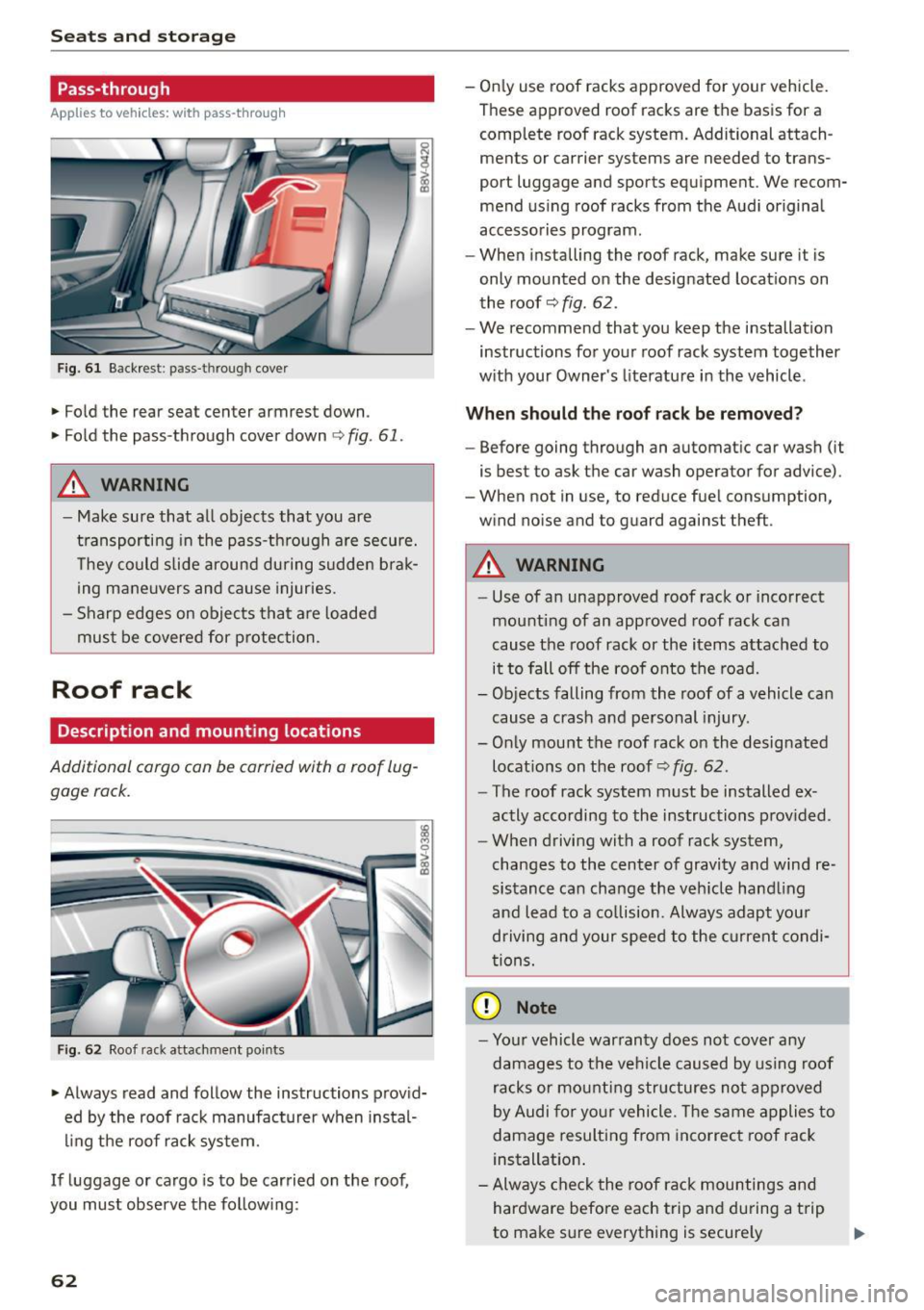
Seats and storag e
Pass-through
Applies to veh icles: w ith pass-t hro ug h
Fig. 6 1 Back rest : pass -through cover
.,. Fold the rear seat center armrest down.
.,. Fo ld the pass-through cover down ¢
fig. 61 .
A WARNING
0 N
i (D
-
- M ake sure that all objects that you are
transporting in the pass-th rough a re secu re.
T hey co uld slide around during sudden brak
ing mane uvers and cause injuries.
- Sharp edges on objects that are loaded
must be covered for protection.
Roof rack
Description and mounting locations
Additional cargo con be carried with a roof lug
gage rock.
Fig. 62 Roof rack attachment points
.,. Always read and follow the instructions provid
ed by the roof rack manufacturer when instal
ling the roof rack sys tem.
If luggage or cargo is to be carried on the roof,
you must observe the follow ing:
62
- On ly use roof racks approved for your vehicle.
These approved roof racks are the basis for a
complete roof rack system. Additional attach
ments or carrier systems are needed to trans
port luggage and sports equipment. We recom
mend us ing roof racks from the Audi original
accessories program.
- When installing the roof rack, make sure it is
only mounted on the designated locat ions on
the roof¢
fig. 62.
- We recommend that you keep the installation
instructions for yo ur roof rack system together
w ith your Owner's literature in the vehicle .
When should the roof rack be remo ved?
- Before going through an automatic car wash (it
is best to ask the car wash operator for advice).
- When not in use, to reduce fuel consumption,
w ind no ise and to guard against theft .
A WARNING
-Use of an unapproved roof rack o r incorrect
mounting of an approved roof rack can
cause the roof rack or the items attached to
it to fall off the roof onto the road.
- Objects falling from the roof of a vehicle can
cause a crash and personal injury.
- Only mount the roof rack on the designated
locat ions on the roof¢
fig . 62.
- The roof rack system must be installed ex
actly according to the instructions p rov ided.
- When driving with a roof rack system,
changes to the center of gravi ty and wind re
sistance ca n change the veh icle hand ling
and lead to a co llision. Always adapt you r
driving and your speed to the current condi
t ions.
(D Note
- Yo ur vehicle war ranty does not cov er any
damages to t he vehi cle caused by using roof
racks or mounting structures not ap proved
by Audi for yo ur vehicle. The same a pplies to
damage resulting from incorrec t roof rack
installation .
- Always che ck the roof rack mountings and
hardware before each trip and du ring a t rip
to make sure everything is secure ly
Page 73 of 282
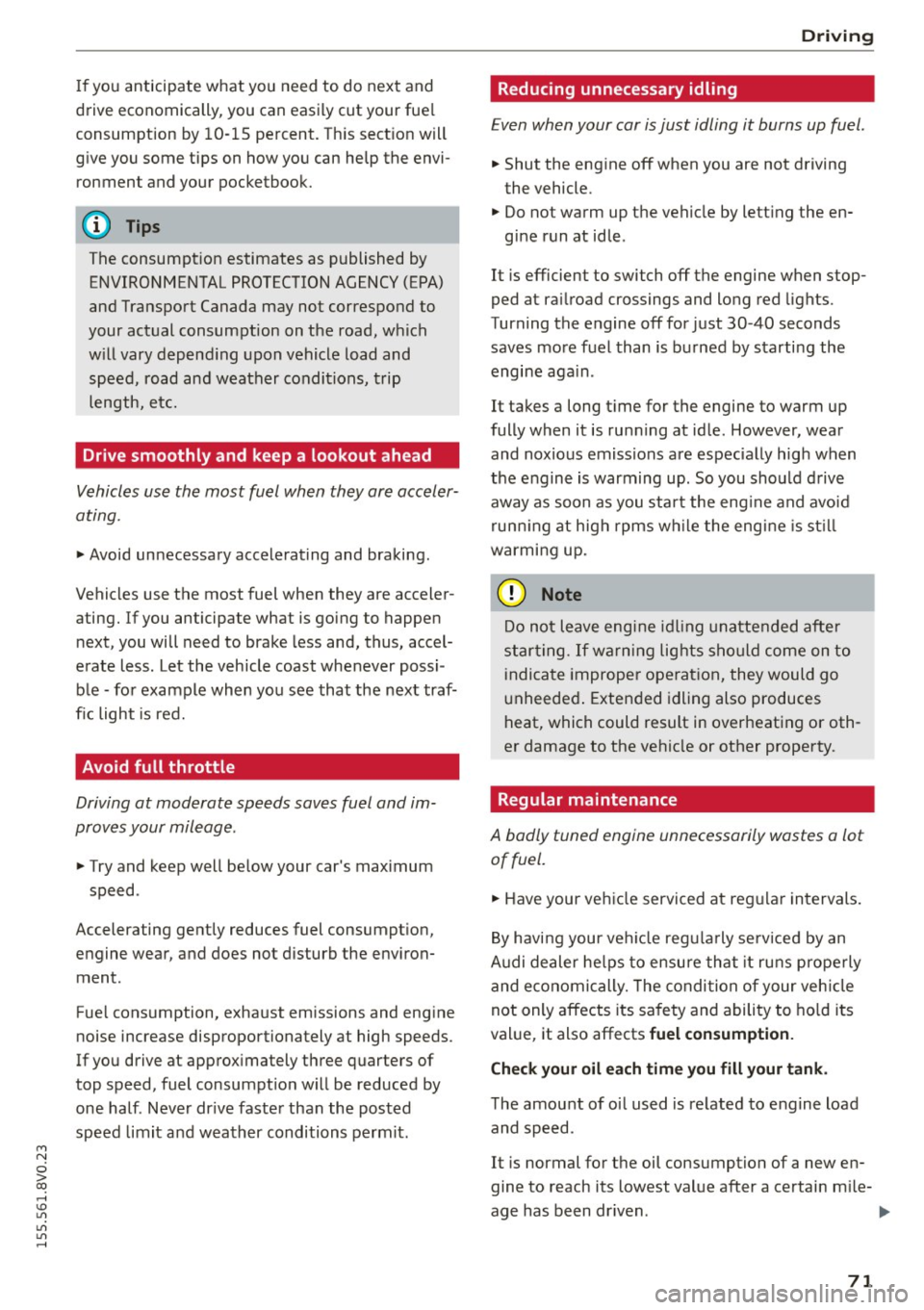
M N
0 > co ,...., \!) 1.1'1
1.1'1
1.1'1
,....,
If you anticipate w hat you need to do next and
drive economically, you can easily cut your fue l
consumption by 10-15 percent. Th is sect ion will
g ive you some tips on how you can help the envi
ronment and your pocketbook.
The consumpt ion estimates as published by
ENVIRONMENTAL PROTECTION AGENCY (EPA)
and Transport Canada may not correspond to
your actual consumption on the road, which
w ill vary depend ing upon vehicle load and
speed, road and weather conditions, trip
length, e tc.
Drive smoothly and keep a lookout ahead
Vehicles use the most fuel when they are acceler
ating.
.. Avoid unnecessary accelerating and braking.
Vehicles use the most fuel when they are acceler
ating. If you anticipate what is going to happen next, you will need to brake less and, thus, accel
erate less. Let the vehicle coast whenever possi b le -for example when you see that the next traf
fic light is red.
Avoid full throttle
Driving at moderate speeds saves fuel and im
proves your mileage .
.. Try and keep well be low your car's max imum
speed .
Accelerating gently reduces fuel consumpt ion,
engine wear, and does not d isturb the env iron
ment .
Fue l consumption, exha ust emissions and eng ine
noise increase disproportionately at high speeds.
If you drive at approx imately t hree quarters of
top speed, fuel consumpt ion w ill be reduced by
one half . Never dr ive faste r than the posted
speed limit a nd weather conditions perm it.
Dri ving
Reducing unnecessary idling
Even when your car is just idling it burns up fuel .
.. Shut the eng ine off when you are not driving
the vehicle .
.. Do not warm up the vehicle by lett ing the en-
gine run at idle.
It is efficient to switch off the engine when stop
ped at ra ilroad crossings and long red lights.
Turning the engine off for just 30-40 seconds
saves more fuel than is b urned by starti ng the
engine aga in .
It takes a long t ime for the engine to warm up
fully when it is ru nning at idle. However, wear
and noxious emissions are espec ia lly hig h when
t h e engine is warming up. So you should d rive
away as soon as you sta rt the eng ine and avoid
run ning at high rpms w hile the eng ine is s till
warmi ng up .
@ Note
Do no t leave eng ine idl ing una ttended afte r
s ta rtin g.
If war ning lig hts s hou ld come on to
i ndica te imprope r operat ion, they would go
u nheede d. Extended idling also produces
heat, which could result in overheat ing or oth
er damage to the ve hicle or other property.
Regular maintenance
A badly tuned engine unnecessarily wastes a lot
of fuel.
.. Have your ve hicle serviced at reg ular in tervals.
B y havi ng your ve hicle regu la rly se rv iced by an
Audi dealer he lps to ensu re that it ru ns p rope rly
and economically. The condi tion of your veh icle
not only affects its sa fety and ability to ho ld i ts
val ue, it also affects
fuel consumption.
Check your oil each time you fill your tank.
The amou nt of oi l used is re lated to engine load
and speed.
It is normal for the oil consumption of a new en
gine to reach its lowest value after a certai n m ile-
age has been dr iven. ...,
71
Page 74 of 282
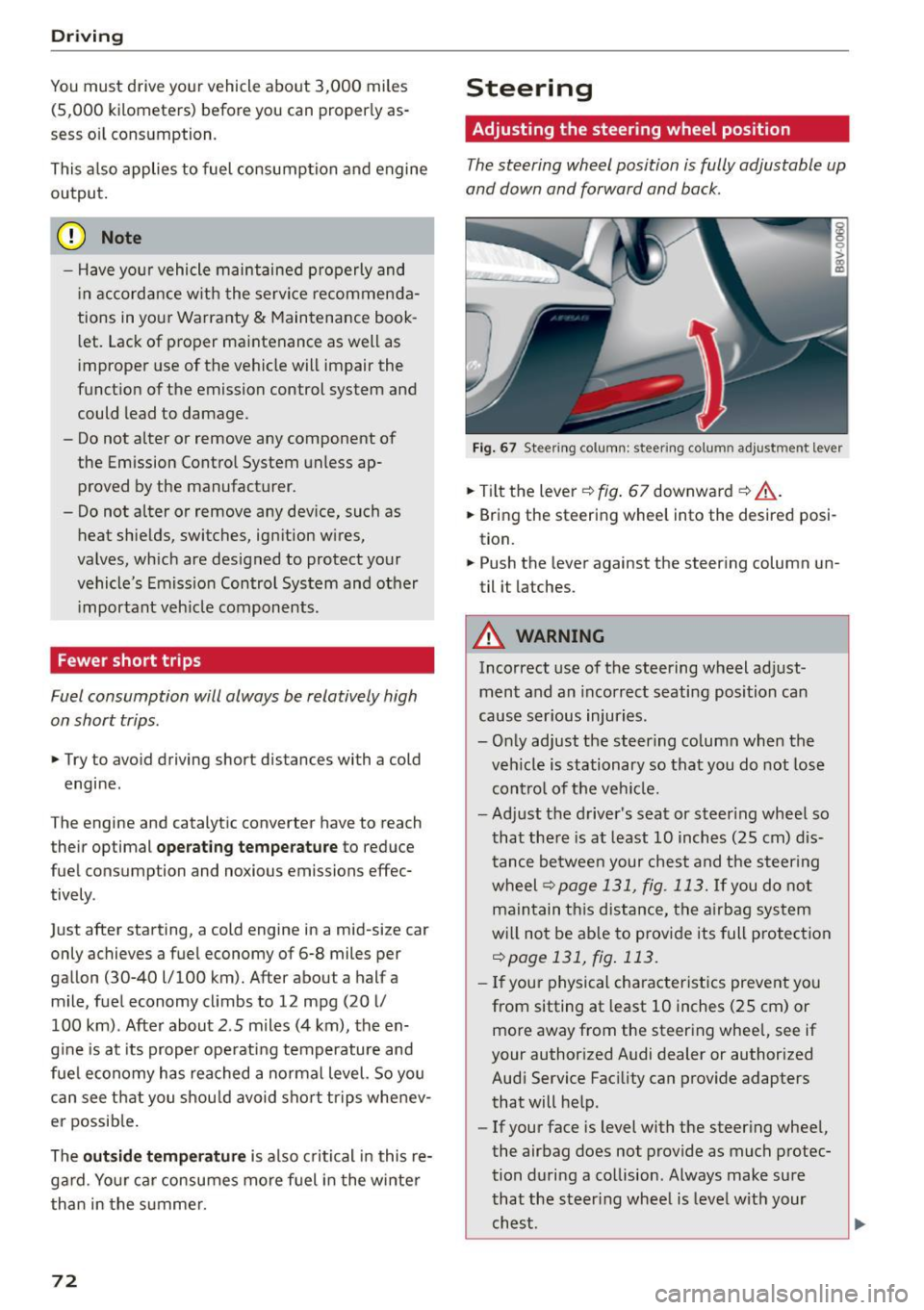
Driving
You must drive your vehicle about 3,000 miles (5,000 kilometers) before you can properly as
sess oil consumption.
This also applies to fuel consumption and engine
output.
@ Note
- Have your vehicle maintained properly and
in accordance w ith the service recommenda
tions in your Warranty
& Maintenance book
let. Lack of proper maintenance as well as
improper use of the vehicle will impair the
function of the emission control system and
could lead to damage.
- Do not alter or remove any component of the Emission Control System unless approved by the manufacturer.
- Do not alter or remove any device, such as heat shields, switches, ignition wires,
valves, which are designed to protect your
vehicle's Emission Control System and other important vehicle components.
Fewer short trips
Fuel consumption will always be relatively high
on short trips.
.,. Try to avoid driving short distances with a cold
engine.
The eng ine and catalytic converter have to reach
their optimal
operating temperature to reduce
fuel consumption and noxious emissions effec
tively .
Just after starting, a cold engine in a mid-size car only achieves a fuel economy of 6-8 miles per
gallon (30-40 l/100 km). After about a half a mile, fuel economy climbs to 12 mpg (20
l/
100 km) . After about 2.5 miles (4 km), the en
gine is at its proper operating temperature and
fuel economy has reached a normal level. So you
can see that you should avoid short trips whenev
er possible.
The
outside temperature is also critical in this re
gard. Your car consumes more fuel in the winter
than in the summer.
72
Steering
Adjusting the steering wheel position
The steering wheel position is fully adjustable up
and down and forward and back .
Fig. 67 Ste ering co lumn : steer ing colu mn adjus tmen t l eve r
.,. Tilt the lever ¢ fig. 67 downward ¢.&, .
.,. Bring the steering wheel into the desired posi
tion.
.,. Push the lever against the steering column un
til it latches .
A WARNING
Incorrect use of the steering wheel adjust
ment and an incorrect seating position can
cause serious injuries.
- Only adjust the steering column when the
vehicle is stationary so that you do not lose
control of the vehicle.
-
-Adjust the driver's seat or steer ing wheel so
that there is at least 10 inches (25 cm) dis
tance between your chest and the steering
wheel ¢
page 131, fig. 113. If you do not
maintain this distance, the airbag system
will not be able to provide its full protection
¢page 131, fig. 113.
-If your physical characteristics prevent you
from sitting at least 10 inches (25 cm) or
more away from the steering wheel, see if
your authorized Audi dealer or authorized
Audi Service Facility can provide adapters that will help.
- If your face is level with the steering wheel,
the airbag does not provide as much protec
tion during a collision . Always make sure
that the steering wheel is level with your
chest .
Page 204 of 282

Checking and F ill in g
Using the proper engine o il is important for the
functionality and service life of the engine. Your
engine was factory-fi lled w ith a high-quality o il
which can usually be used throughout the ent ire
year.
@) Note
Your L imited New Vehicle Warranty does not
cover damage or malfunctions due to failure
to follow recommended ma intenance and use
requ irements as set forth in the Audi Ow ne r's
Manual and Wa rranty
& Ma intenance booklet .
- Use only a high quality eng ine oil t hat ex-
pressly comp lies w ith the Audi o il quality
standard specified for your vehicle's e ngine .
Using a ny other oil can cause se rious engine
damage.
- Do not mix any lubricants o r othe r addit ives
i nto the engine oil. Doing so can cause en
g ine damage.
(D Tips
If you need to add oil and there is none availa
ble that meets the Audi o il quality standard
y o ur eng ine requires, you m ay add a total of
no more than 0.5 quart/li ter o f a h igh-quali ty
"synthet ic"oil that meets the fo llowing speci
fications .
- V ehicles wi th gasoline engine: AC EA A3 o r
API SM with a viscosity grade of SAE 0W- 30,
SAE SW -30 or SAE SW-40 .
- Vehicles with d iesel engine: ACEA C3 o r
API CF with a viscosity g rade of SAE 0W-30
or SAE SW-30.
- Fo r more information abo ut engine oi l t h at
has been approved for your vehicle, please
contact either your a uthorized Audi dea ler
or Audi Customer Relations at
1 (800) 822-2834 or visit ou r web site at
www.aud iusa.com or www .aud icanada .ca.
Engine oil consumption
The engine in your vehicle depends on an ade
quate amount of oil to lubricate and cool all of
its moving parts .
In order to provide effective lubrication and cool ing of in ternal engine components, all internal
202
combust ion engines consume a certa in amoun t
of oil. Oil consumptio n varies from engine to en
gine and may change sign ificant ly over the li fe of
the engine . Typically, eng ines with a specif ied
break-in period (see
¢ page 70) consume more
o il dur ing the break-in per iod than they consume
after oil consumption has s tabilized .
Under normal cond itions, the rate of oil con
sump tion depends on the quality and viscos ity of
the oil, the RPM (revolutions per minute) at
wh ich the engine is operated, the ambie nt tem
perature and road cond it ions . Furthe r facto rs a re
t h e amo unt of o il di lution from water conde nsa
t ion or fue l residue and the ox idat ion leve l o f the
o il. As any engine is s ubject to wear as mileage
builds up, the oil consumption may increase ove r
time unt il rep lacement of wo rn components may
become necessary.
With a ll these va riab les coming into p lay, no
standard rate of oil consumption can be estab
li shed or spec ified. There is no alte rnative to reg
ul ar and frequent checking o f the oil leve l, see
Note .
If the yellow engine oi l level warning sym bo l Ill
in the instrument cluster lights up, yo u should
check the o il level as soon as possible
¢ page 203. Top off the oil at your earliest con
venience
¢ page 203.
A WARNING
Before you c heck anythi ng in the eng ine com
partment, always read and heed al l WAR N
IN GS ¢page 198.
(D Note
Driving w it h an insufficient o il level is likely to
cause severe damage to the engine.
(D Tips
- The oil pressure warning d isplay. is not
an indicator of the oil level. Do not rely on
it. Instead, check th e oil level in your en
gine at regular intervals, preferably each
time you refuel , and alway s before going
on a long trip.
Page 205 of 282

....,
N
0 > co
rl I.O
"'
"'
"'
rl
-If you have the impression your engine con
sumes excessive amounts of oi l, we recom
mend that you consult an authorized Audi
dealer to have the cause of your concern
properly diagnosed. Keep in mind that the
accurate measurement of oil consumption
requires great care and may take some time.
An authorized Audi dealer has instr uctions
about how to measure oil consumption ac
curately.
Checking the engine oil level
Fig. 159 Gasoline engine oil dipstick: guide for measuring
t h e oil leve l (example)
F ig . 160 Diesel engine oil dipstick : g ui de for measuring the
oil level (example)
Determining the oil level
• Park your vehicle on a level surface.
• Let the engine run in idle briefly while it is at
operating temperature and then shut the en gine off.
• Wait approximately two minutes.
• Remove the oil dipstick. Wipe off the oil dip
stick with a clean cloth and insert it all the way
in again .
• Remove the dipstick again and then read the oil
level¢
fig. 159 or ¢ fig. 160.
Checking and Filling
• Evaluate the oil leve l c;, table on page 203. Add
engine oi l if necessary
¢ page 203.
0 You must add o il. After adding oil, the level
shou ld be in the@ area.
@ You may add oil. After adding oil, the leve l
shou ld be in the@ area.
0 Do not add any oil.
@ Do not add any oil. You may continue driv-
ing.
0 Do not add any oil. Drive to an author ized
A udi dealer or authorized A udi Service Fa-
cility immediately.
Applies to vehicles with diesel engines: if you op
erate your vehicle with biodiesel, fuel may enter
the engine oil. This raises the oi l level in the en
gine. It also decreases the quality of the engine
oil ¢page23.
The oil consumption of the engine may be up to
1/2 quart per 600 mi les (0 .5 liter per 1,000 km),
depending on driving style and cond itions. Con
s umption may be higher during the first
3,000 miles (5,000 km). Because of this, the en
gine oil level must be checked regularly. It would
be best to check each time you refue l your vehicle
and before long drives.
Adding engine oil 't::7:
Fig. 161 Engine compa rtment: e ngine oil fille r opening
cover
• Tur n the engine off .
• Unscrew the engine oil filler opening cap
• Carefully add 0.5 quart (0.S liter) of the appro-
priate oil
c;, page 201. .,..
203
Page 227 of 282
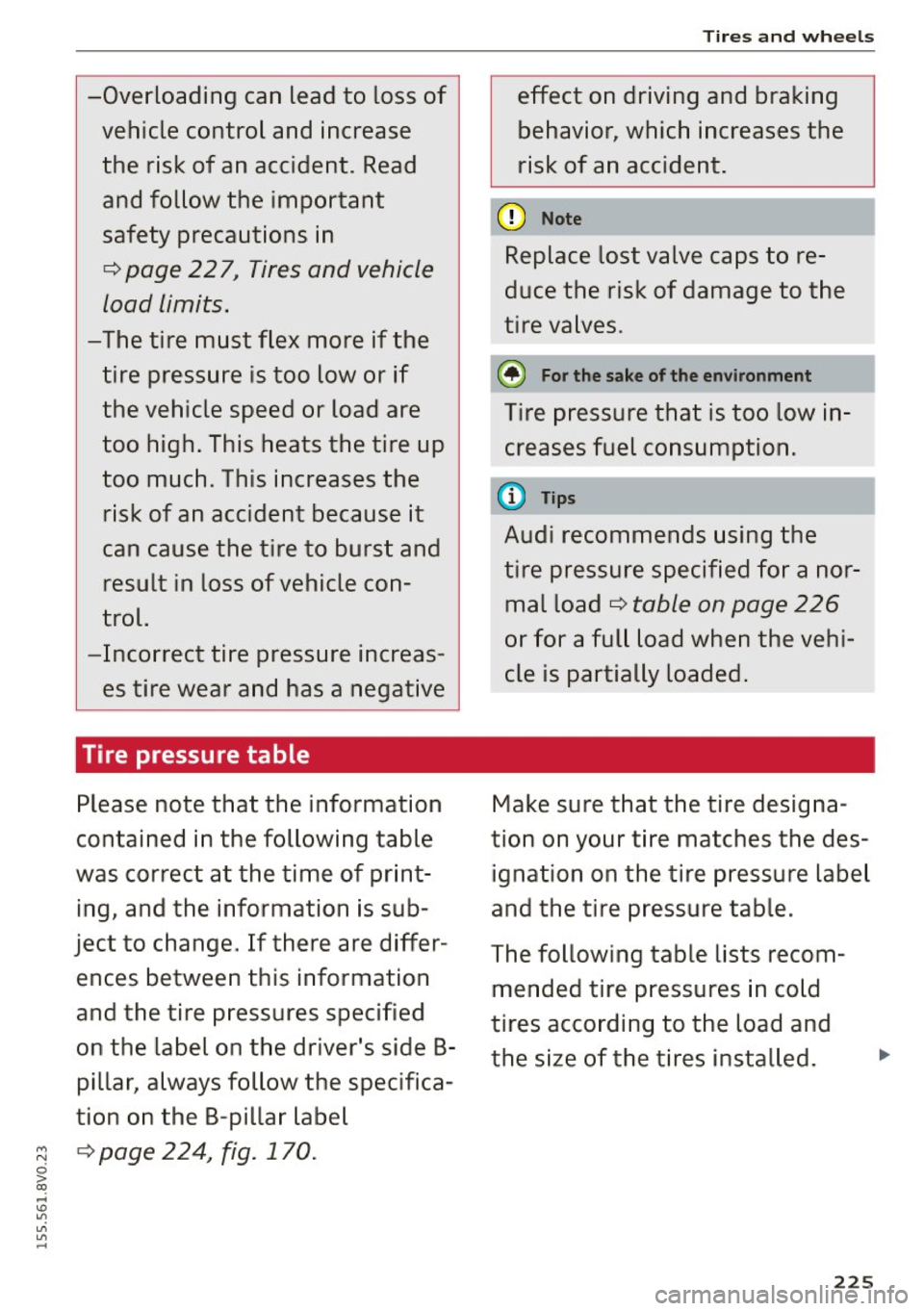
-Overloading can lead to loss of
vehicle control and increase the risk of an accident. Read
and follow the important
safety precautions in
¢ page 22 7, Tires and vehicle
load limits.
-The tire must flex more if the
tire pressure is too low or if the vehicle speed or load are
too high. This heats the tire up
too much. This increases the risk of an accident because it
can cause the tire to burst and result in loss of vehicle con
trol.
-Incorrect tire pressure increas
es tire wear and has a negative
Tire pressure table
Please note that the information
contained in the following table
was correct at the time of print ing, and the information is sub
ject to change. If there are differ ences between this information
and the tire pressures specified on the label on the driver's side B
pillar, always follow the specifica
tion on the B-pillar label
¢ page 224, fig. 170.
Tires and wheels
effect on driving and braking
behavior, which increases the
risk of an accident.
Replace lost valve caps to re
duce the risk of damage to the
tire valves .
@ For the sake of the environment
Tire pressure that is too low in
creases fuel consumption.
(1) Tips
Audi recommends using the
tire pressure specified for a normal load
¢ table on page 226
or for a full load when the vehi
cle is partially loaded.
Make sure that the tire designa
tion on your tire matches the des ignation on the tire pressure label
and the tire pressure table .
The following table lists recom mended tire pressures in cold
tires according to the load and
the size of the tires installed.
225
Page 269 of 282
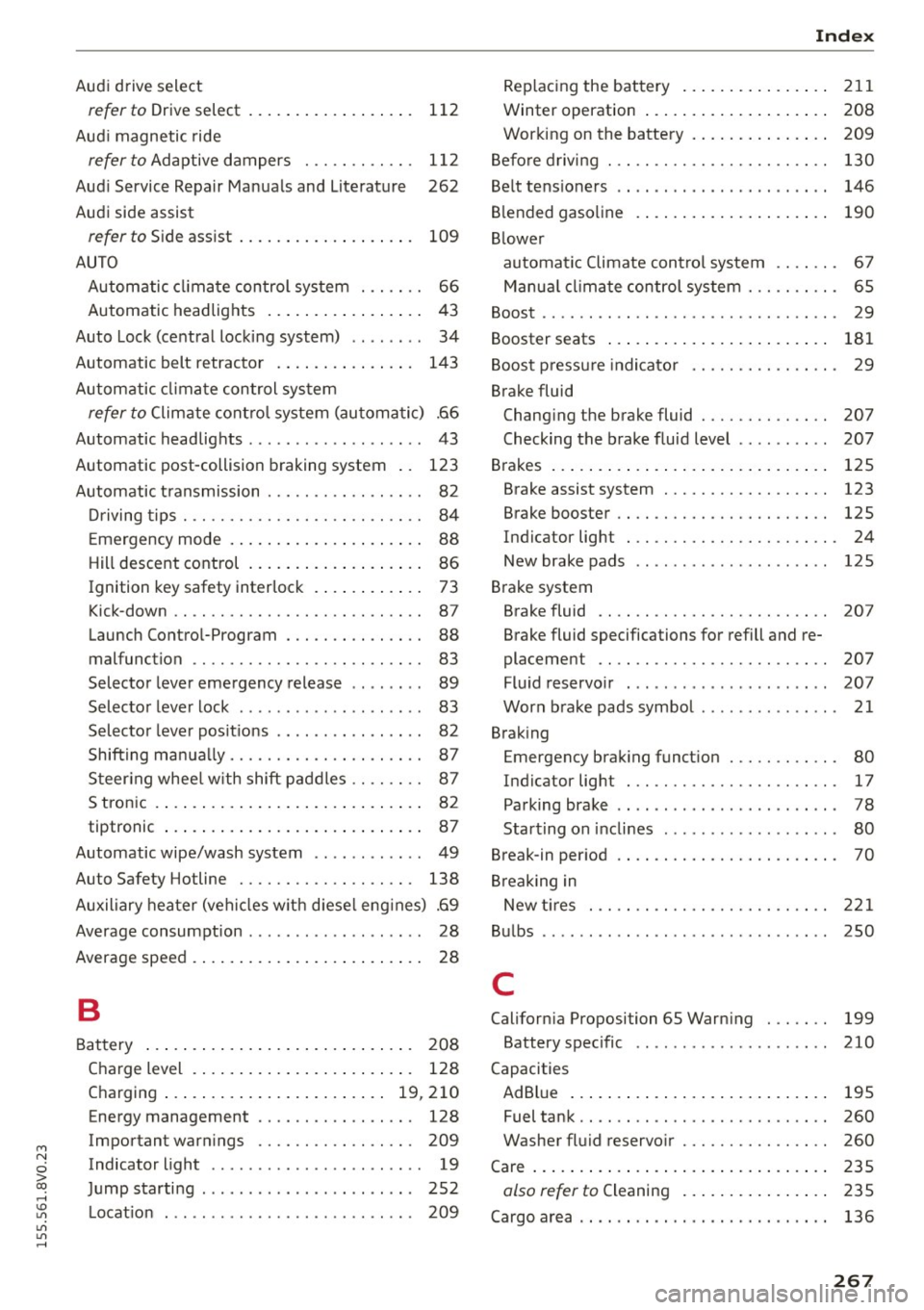
M N
0 > co ,...., \!) 1.1'1
1.1'1
1.1'1
,....,
Audi drive select
refer to Drive select . . . . . . . . . . . . . . . . . . 112
Aud i magnetic ride
refer to Adaptive dampers . . . . . . . . . . . . 112
Aud i Service Repair Manuals and Literature 262
Aud i side assist
refer to Side assist . . . . . . . . . . . . . . . . . . . 109
AUTO
Automatic climate control system . . . . . . . 66
Automatic headlights . . . . . . . . . . . . . . . . . 43
Auto Lock (central locking system) . . . . . . . . 34
Automatic belt retractor . . . . . . . . . . . . . . . 143
Automatic climate control system
refer to Climate control system (automatic) .66
Automatic headlights . . . . . . . . . . . . . . . . . . . 43
Automatic post-collision braking system . . 123
Automatic transmission . . . . . . . . . . . . . . . . . 82
Driving tips . . . . . . . . . . . . . . . . . . . . . . . . . . 84
Emergency mode . . . . . . . . . . . . . . . . . . . . . 88
Hill descent control . . . . . . . . . . . . . . . . . . . 86
Ignition key safety interlock . . . . . . . . . . . . 73
Kick-down . . . . . . . . . . . . . . . . . . . . . . . . . . . 8 7
Launch Control-Program . . . . . . . . . . . . . . . 88
malfunction . . . . . . . . . . . . . . . . . . . . . . . . .
83
Selector lever emergency release . . . . . . . . 89
Selector lever lock . . . . . . . . . . . . . . . . . . . . 83
Selector lever pos it ions . . . . . . . . . . . . . . . . 82
Shifting manually . . . . . . . . . . . . . . . . . . . . . 87
Steer ing whee l w ith shift paddles . . . . . . . . 87
S tronic . . . . . . . . . . . . . . . . . . . . . . . . . . . . . 82
tiptronic . . . . . . . . . . . . . . . . . . . . . . . . . . . . 87
Automatic wipe/wash system . . . . . . . . . . . . 49
Auto Safety Hotline . . . . . . . . . . . . . . . . . . . 138
Auxiliary heater (vehicles w ith diese l eng ines) .69
Average consumption . . . . . . . . . . . . . . . . . . . 28
Average speed . . . . . . . . . . . . . . . . . . . . . . . . . 28
B
Battery . . . . . . . . . . . . . . . . . . . . . . . . . . . . . 208
Charge level . . . . . . . . . . . . . . . . . . . . . . . . 128
Charging ... .. .............. ... .. 19,210
Energy management . . . . . . . . . . . . . . . . . 128
Important warnings . . . . . . . . . . . . . . . . . 209
Indicator light . . . . . . . . . . . . . . . . . . . . . . . 19
Jump starting . . . . . . . . . . . . . . . . . . . . . . . 252
L ocat ion . . . . . . . . . . . . . . . . . . . . . . . . . . . 209
Index
Replacing the battery . . . . . . . . . . . . . . . . 211
Winter operation . . . . . . . . . . . . . . . . . . . . 208
Working on the battery . . . . . . . . . . . . . . . 209
Before driving . . . . . . . . . . . . . . . . . . . . . . . . 130
Belt tens ioners . . . . . . . . . . . . . . . . . . . . . . . 146
B lended gasol ine . . . . . . . . . . . . . . . . . . . . . 190
B lower
automatic Climate control system . . . . . . . 67
Manual climate control system . . . . . . . . . . 65
Boost . . . . . . . . . . . . . . . . . . . . . . . . . . . . . . . . 29
Booster seats . . . . . . . . . . . . . . . . . . . . . . . . 181
Boost pressu re indicator . . . . . . . . . . . . . . . . 29
Brake fluid Changing the brake fluid . . . . . . . . . . . . . . 207
Checking the brake fluid level . . . . . . . . . . 207
Brakes . . . . . . . . . . . . . . . . . . . . . . . . . . . . . . 125
Brake assist system . . . . . . . . . . . . . . . . . . 123
Brake booster . . . . . . . . . . . . . . . . . . . . . . . 125
Indicator ligh t . . . . . . . . . . . . . . . . . . . . . . . 24
New brake pads . . . . . . . . . . . . . . . . . . . . . 125
Brake system Brake fluid . . . . . . . . . . . . . . . . . . . . . . . . . 20 7
Brake fluid specifications for refill and re
placement . . . . . . . . . . . . . . . . . . . . . . . . . 207
Fluid reservoir . . . . . . . . . . . . . . . . . . . . . . 207
Worn brake pads symbol . . . . . . . . . . . . . . . 21
Braking Emergency braking function . . . . . . . . . . . . 80
Indicator light . . . . . . . . . . . . . . . . . . . . . . . 17
Parking brake . . . . . . . . . . . . . . . . . . . . . . . . 78
Starting on inclines . . . . . . . . . . . . . . . . . . . 80
Break-in per iod . . . . . . . . . . . . . . . . . . . . . . . . 70
Breaking in New t ires ..... .. ............. .... .. 221
Bulbs . . . . . . . . . . . . . . . . . . . . . . . . . . . . . . . 250
C
California Proposition 65 Warning . . . . . . . 199
Battery specific . . . . . . . . . . . . . . . . . . . . . 210
Capacities AdBlue . . . . . . . . . . . . . . . . . . . . . . . . . . . . 195
Fuel tank. . . . . . . . . . . . . . . . . . . . . . . . . . . 260
Washer fluid reservoir . . . . . . . . . . . . . . . . 260
Care . . . . . . . . . . . . . . . . . . . . . . . . . . . . . . . . 235
olso refer to Cleaning . . . . . . . . . . . . . . . . 235
Cargo area . . . . . . . . . . . . . . . . . . . . . . . . . . . 136
267
Page 271 of 282
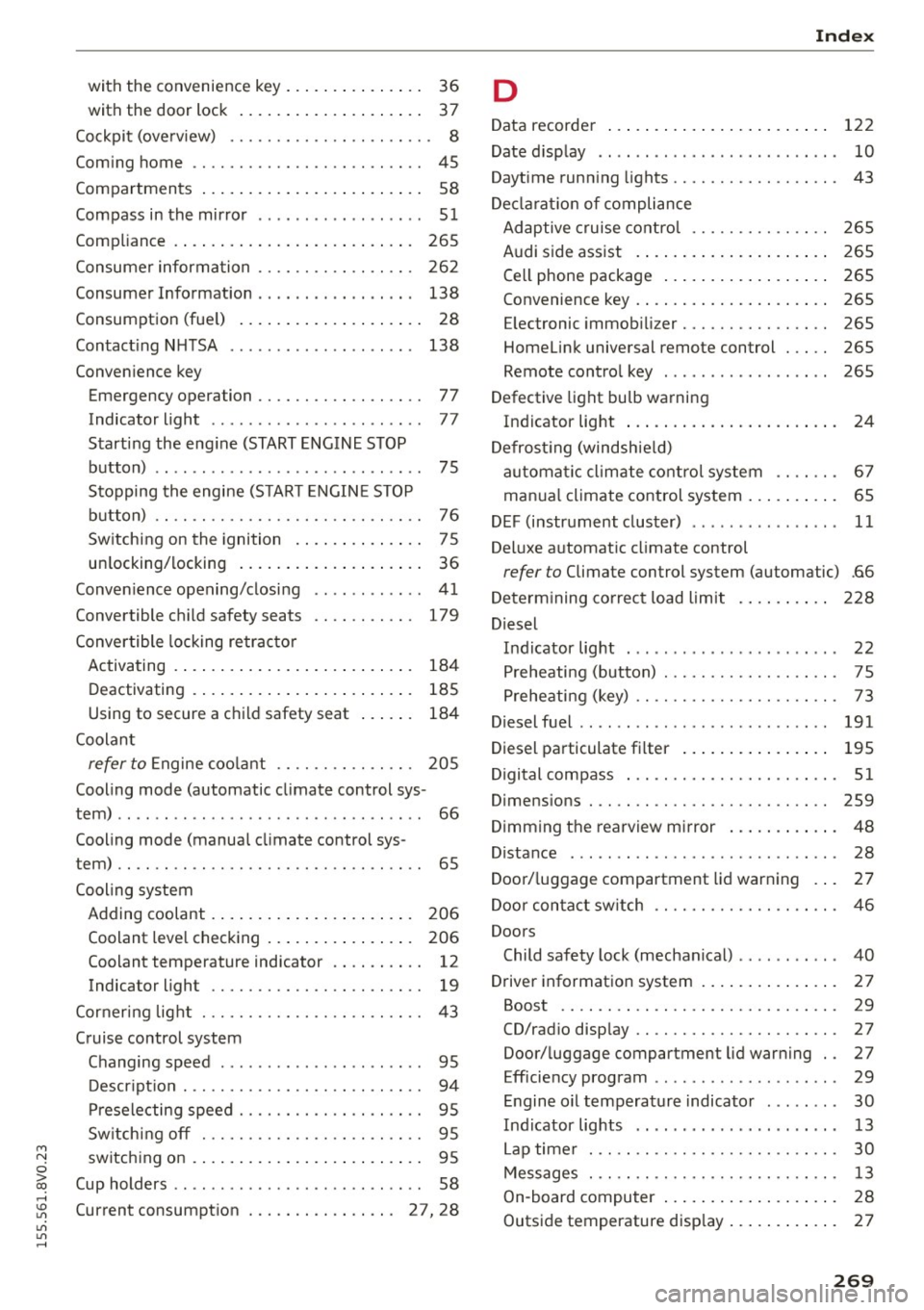
with the convenience key. . . . . . . . . . . . . . . 36
with the door lock . . . . . . . . . . . . . . . . . . . . 3 7
Cockpit (overview) . . . . . . . . . . . . . . . . . . . . . . 8
Coming home . . . . . . . . . . . . . . . . . . . . . . . . . 45
Compartments . . . . . . . . . . . . . . . . . . . . . . . . 58
Compass in the mirror . . . . . . . . . . . . . . . . . . 51
Compliance . . . . . . . . . . . . . . . . . . . . . . . . . . 265
Consumer information . . . . . . . . . . . . . . . . . 262
Consumer Information . . . . . . . . . . . . . . . . . 138
Consumption (fuel) . . . . . . . . . . . . . . . . . . . . 28
Contacting NHTSA . . . . . . . . . . . . . . . . . . . . 138
Convenience key Emergency operation . . . . . . . . . . . . . . . . . . 77
Indicator light . . . . . . . . . . . . . . . . . . . . . . . 77
Starting the engine (START ENGINE STOP button) . . . . . . . . . . . . . . . . . . . . . . . . . . . . . 75
Stopping the engine (STAR T ENGIN E STOP
button) . . . . . . . . . . . . . . . . . . . . . . . . . . . . . 76
Sw itching on the ignit ion . . . . . . . . . . . . . . 75
un locking/locking . . . . . . . . . . . . . . . . . . . . 36
Convenience opening/closing . . . . . . . . . . . . 41
Convertible child safety seats . . . . . . . . . . . 179
Convertible locking retractor
Activating . . . . . . . . . . . . . . . . . . . . . . . . . . 184
Deact ivating . . . . . . . . . . . . . . . . . . . . . . . . 185
Using to secure a child safety seat . . . . . . 184
Coolant
refer to Engine coolant . . . . . . . . . . . . . . . 205
Cooling mode (automatic climate control sys-
tem) . . . . . . . . . . . . . . . . . . . . . . . . . . . . . . . . . 66
Cooling mode (manua l climate control sys -
tem)................................. 65
Cooling system Adding coolant . . . . . . . . . . . . . . . . . . . . . . 206
Coolant leve l checking . . . . . . . . . . . . . . . . 206
Coolant temperature indicator . . . . . . . . . . 12
Indicator light . . . . . . . . . . . . . . . . . . . . . . . 19
Cornering light . . . . . . . . . . . . . . . . . . . . . . . . 43
Cruise control system Changing speed . . . . . . . . . . . . . . . . . . . . . . 95
D escr iption . . . . . . . . . . . . . . . . . . . . . . . . . . 94
Preselecting speed . . . . . . . . . . . . . . . . . . . . 95
Sw itch ing off . . . . . . . . . . . . . . . . . . . . . . . . 95
~ switching on . . . . . . . . . . . . . . . . . . . . . . . . . 95 0
iii Cup holders . . . . . . . . . . . . . . . . . . . . . . . . . . . 58 ,....,
~ Current consumpt ion ................ 27, 28
Vl
Vl
,....,
Index
D
Data recorder . . . . . . . . . . . . . . . . . . . . . . . . 122
Date display . . . . . . . . . . . . . . . . . . . . . . . . . . 10
Daytime running lights. . . . . . . . . . . . . . . . . . 43
Declaration of compliance
Adaptive cruise control . . . . . . . . . . . . . . . 265
Audi side assist . . . . . . . . . . . . . . . . . . . . . 265
Cell phone package . . . . . . . . . . . . . . . . . . 265
Convenience key . . . . . . . . . . . . . . . . . . . . . 265
E le ctronic immobili zer . . . . . . . . . . . . . . . . 265
Homelink universal remote control . . . . . 265
Remote control key . . . . . . . . . . . . . . . . . . 265
Defective light bulb warning
Indicator light . . . . . . . . . . . . . . . . . . . . . . . 24
Defrost ing (windshield)
automatic climate control system . . . . . . . 67
manual climate control system . . . . . . . . . . 65
DEF (instrument cluster) . . . . . . . . . . . . . . . . 11
Deluxe automatic cl imate control
refer to Climate control system (automatic) .66
Determining correct load limit . . . . . . . . . . 228
Diesel
Indicator light . . . . . . . . . . . . . . . . . . . . . . . 22
Preheating (button) . . . . . . . . . . . . . . . . . . . 75
Preheating (key) . . . . . . . . . . . . . . . . . . . . . . 73
Diesel fuel . . . . . . . . . . . . . . . . . . . . . . . . . . . 191
Diesel particulate filter . . . . . . . . . . . . . . . . 195
Digital compass . . . . . . . . . . . . . . . . . . . . . . . 51
Dimensions . . . . . . . . . . . . . . . . . . . . . . . . . . 259
Dimming the rearview mirror . . . . . . . . . . . . 48
Distance . . . . . . . . . . . . . . . . . . . . . . . . . . . . . 28
Door/luggage compartment lid warning . . . 27
Door contact sw itch . . . . . . . . . . . . . . . . . . . . 46
Doors Child safety lock (mechanical) . . . . . . . . . . . 40
Driver informa tion system . . . . . . . . . . . . . . . 27
Boost . . . . . . . . . . . . . . . . . . . . . . . . . . . . . . 29
CD/rad io display . . . . . . . . . . . . . . . . . . . . . . 27
Door/luggage compartment lid warning . . 27
Efficie ncy program . . . . . . . . . . . . . . . . . . . . 29
Engine oil temperature indicator . . . . . . . . 30
Indicator lights . . . . . . . . . . . . . . . . . . . . . . 13
Lap timer . . . . . . . . . . . . . . . . . . . . . . . . . . . 30
Messages . . . . . . . . . . . . . . . . . . . . . . . . . . . 13
On -board computer . . . . . . . . . . . . . . . . . . . 28
Outside temperature display . . . . . . . . . . . . 27
269